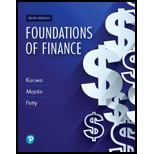
EBK FOUNDATIONS OF FINANCE
10th Edition
ISBN: 9780135160473
Author: KEOWN
Publisher: PEARSON CO
expand_more
expand_more
format_list_bulleted
Concept explainers
Textbook Question
Chapter 7, Problem 1SP
(
Expert Solution & Answer
Want to see the full answer?
Check out a sample textbook solution
Students have asked these similar questions
Need help
2. What is the future value of $3,000 invested at 8% interest for 5 years?
1. Calculate EPS for a company with net income $1,500,000 and 500,000 shares outstanding .need help
What is the future value of $5,000 invested for 3 years at an annual interest rate of 6% compounded annuallySolve it plz
Chapter 7 Solutions
EBK FOUNDATIONS OF FINANCE
Ch. 7 - Prob. 1RQCh. 7 - Prob. 2RQCh. 7 - Prob. 3RQCh. 7 - a. How does a bonds par value differ from its...Ch. 7 - Prob. 5RQCh. 7 - Prob. 6RQCh. 7 - Prob. 7RQCh. 7 - Prob. 8RQCh. 7 - Prob. 9RQCh. 7 - Define the expected rate of return to bondholders.
Ch. 7 - (Bond valuation) Bellingham bonds have an annual...Ch. 7 - (Bond valuation) Flora Co.s bonds, maturing in 7...Ch. 7 - (Bond valuation) You own a 20-year, 1,000 par...Ch. 7 - (Bond valuation) Calculate the value of a bond...Ch. 7 - (Bond valuation) At the beginning of the year, you...Ch. 7 - Prob. 6SPCh. 7 - (Bond relationship) Mason, Inc. has two bond...Ch. 7 - Prob. 8SPCh. 7 - (Bond valuation) National Steels 15-year, 1,000...Ch. 7 - (Bond valuation) You own a bond that pays 70 in...Ch. 7 - Prob. 11SPCh. 7 - (Bond valuationzero coupon) The Latham Corporation...Ch. 7 - (Bond valuation) Bank of America has bonds that...Ch. 7 - Prob. 15SPCh. 7 - Prob. 16SPCh. 7 - Prob. 17SPCh. 7 - (Bondholders expected rate of return) You own a...Ch. 7 - (Expected rate of return and current yield) Time...Ch. 7 - (Expected rate of return and current yield)...Ch. 7 - Prob. 21SPCh. 7 - Prob. 22SPCh. 7 - (Current yield) Assume you have a bond with a...Ch. 7 - Prob. 24SPCh. 7 - (Expected rate of return) Assume you own a bond...Ch. 7 - Prob. 26SPCh. 7 - (Bondholders expected rate of return) You...Ch. 7 - Prob. 1MCCh. 7 - Assume that the bonds are selling for the...Ch. 7 - Prob. 3MCCh. 7 - Prob. 4MCCh. 7 - Prob. 5MC
Knowledge Booster
Learn more about
Need a deep-dive on the concept behind this application? Look no further. Learn more about this topic, finance and related others by exploring similar questions and additional content below.Similar questions
- What is the future value of $5,000 invested for 3 years at an annual interest rate of 6% compounded annually need helparrow_forwardNo ai ...??? Gpt correct an7. If sales are $1,000,000 and net income is $150,000, what is the profit margin?arrow_forwardWhat is the future value of $5,000 invested for 3 years at an annual interest rate of 6% compounded annually ?arrow_forward
- If a bond has a face value of $1,000, a coupon rate of 5%, and pays interest annually, what is the annual interest payment? A) $50B) $100C) $500D) $5 help me plarrow_forwardIf a bond has a face value of $1,000, a coupon rate of 5%, and pays interest annually, what is the annual interest payment? A) $50B) $100C) $500D) $5 need helparrow_forwardIf a bond has a face value of $1,000, a coupon rate of 5%, and pays interest annually, what is the annual interest payment?arrow_forward
- If a bond has a face value of $1,000, a coupon rate of 5%, and pays interest annually, what is the annual interest payment? A) $50B) $100C) $500D) $5arrow_forwardNo ai gpt ....????arrow_forwardYou invest $2,000 in a savings account that pays 4% interest compounded annually. How much will you have after 2 years? A) $2,080B) $2,160C) $2,081.60D) $2,000steps!arrow_forward
- You invest $2,000 in a savings account that pays 4% interest compounded annually. How much will you have after 2 years? Need helparrow_forwardA company issues 1,000 shares at $25 each. What is the total capital raised? A) $2,500B) $25,000C) $250D) $2,000arrow_forwardYou invest $2,000 in a savings account that pays 4% interest compounded annually. How much will you have after 2 years? A) $2,080B) $2,160C) $2,081.60D) $2,000need help!!arrow_forward
arrow_back_ios
SEE MORE QUESTIONS
arrow_forward_ios
Recommended textbooks for you
 Intermediate Financial Management (MindTap Course...FinanceISBN:9781337395083Author:Eugene F. Brigham, Phillip R. DavesPublisher:Cengage Learning
Intermediate Financial Management (MindTap Course...FinanceISBN:9781337395083Author:Eugene F. Brigham, Phillip R. DavesPublisher:Cengage Learning

Intermediate Financial Management (MindTap Course...
Finance
ISBN:9781337395083
Author:Eugene F. Brigham, Phillip R. Daves
Publisher:Cengage Learning
Bond Valuation - A Quick Review; Author: Pat Obi;https://www.youtube.com/watch?v=xDWTPmqcWW4;License: Standard Youtube License